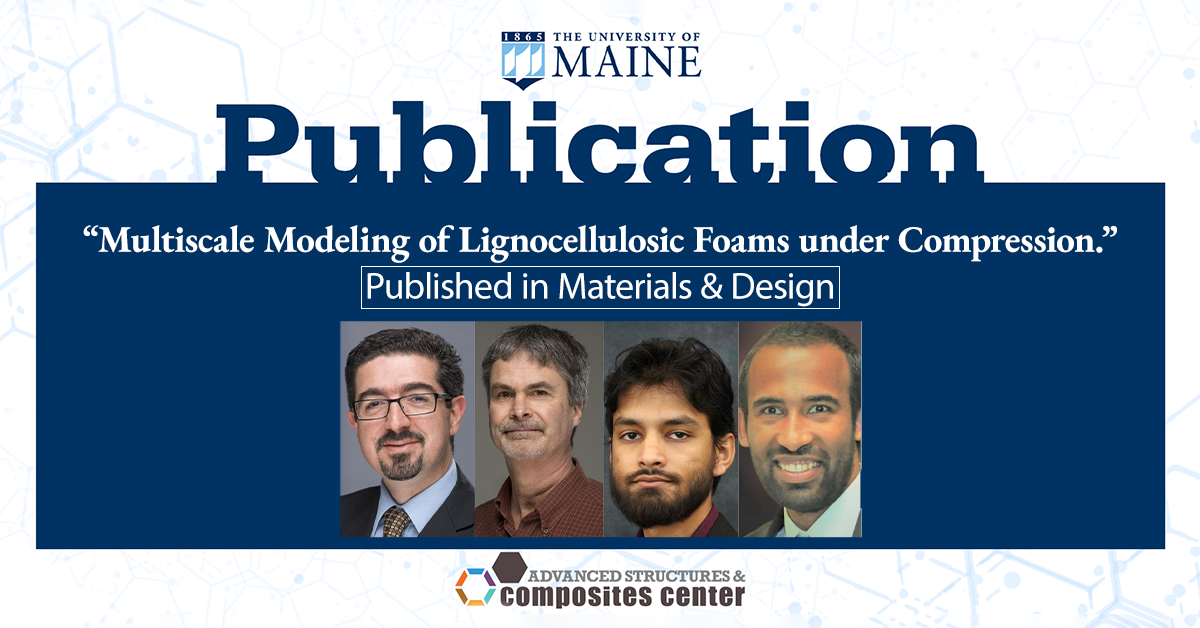
Article by Tajvidi on multiscale modeling of lignocellulosic foams published in Materials & Design
Orono, Maine — An article by ASCC researcher Mehdi Tajvidi, other School of Forest Resources researchers Islam Hafez and Mohammad Tauhiduzzaman, and Department of Chemical and Biomedical Engineering researcher Douglas Bousfield, was published in Materials & Design. The paper is titled “Multiscale Modeling of Lignocellulosic Foams under Compression.”
Foam products from non-renewable and non-biodegradable plastics are widely used, and often end up in landfills. UMaine researchers explore the potential to replace polymer foams with a low-density renewable biocomposite made from wood particles and cellulose nanofibrils (CNF). This study focuses on the production of lignocellulosic foams using wood flour or thermochemical pulp (TMP) fibers bound with CNFs. A multiscale model using finite element analysis (FEA) was developed to predict the elastic-plastic material properties of lignocellulosic foams subjected to compression.
The article describes the manufacturing process and characterization of lignocellulosic foams experimentally and numerically. The compressive modulus of lignocellulosic foams is one of the most important features to withstand impacts, shocks, and external conditions caused by temperature to effectively replace plastic foams, and the modeling results at different scales indicate a robust numerical framework to predict the mechanical behavior of lignocellulosic foams. In summary, this work contributes to the development of the design and damage tolerance of biodegradable lignocellulosic foams.
Multiscale Modeling of Lignocellulosic Foams under Compression
Authors: Mohammad Tauhiduzzaman, Islam Hafez, Douglas Bousfield, Mehdi Tajvidi
Materials & Design(2022)
Full Article
Received: 07 September 2022 / Accepted: 05 December 2022 / Published: 06 December 2022
Abstract
Biodegradable lignocellulosic foams have the potential to replace foams produced from petroleum sources that have environmental issues. These lignocellulosic foams contain randomly oriented fibers or particles bonded by cellulose nanofibrils (CNFs). In this work, effort was focused on the production of lignocellulosic foams using wood flour or thermomechanical pulp (TMP) fibers bound with CNFs. Multiscale modeling is proposed to predict the mechanical properties. Microwave drying was employed to produce the low-density porous foam structures. Compression tests conducted on the foams exhibited elastic-plastic responses. Finite element analysis (FEA), a numerical method to determine the elastic-plastic mechanical properties was utilized. The Young’s modulus of lignocellulosic foams calculated from fiber-scale modeling Methods exhibits strong agreement with experimental results for strains up to 10%. Meso-scale modeling indicates a FEA approach to determine Young’s modulus considering cellulose as matrix and porosity inclusions to create different porous structures. Macro-scale FEA was performed using crushable foam material model to determine the elastic-plastic behavior of the foams for strains up to 20% reveals a solid agreement with the experimental results. Modeling results at different scales promise a robust numerical framework to predict mechanical behavior of these novel lignocellulosic foams.
Keywords: Multiscale Modeling, Finite Element Analysis (FEA), Cellulose Nanofibrils (CNFs), Homogenization, Representative Volume Element (RVE), Lignocellulosic Foams
Article by Tajvidi on multiscale modeling of lignocellulosic foams published in Materials & Design
Contact: Katelin Moody, katelin.moody@maine.edu
